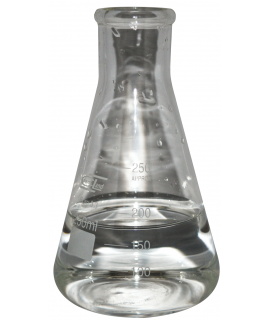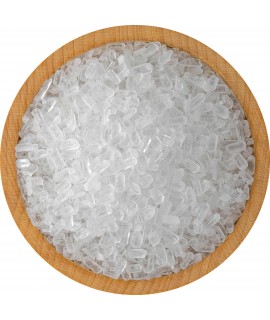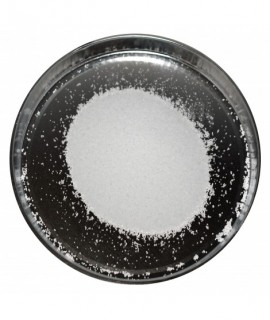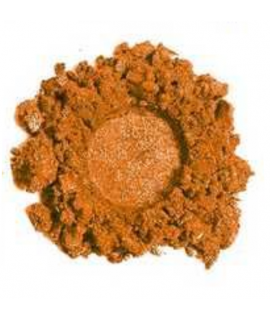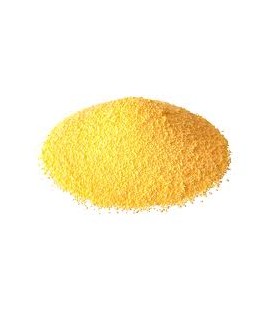METHANESULFONIC ACID, MSA, 70%, L
7.90 €
Methanesulfonic acid, CAS 75-75-2, MSA, methylsulfonic acid, mesylic acid, methanosulfonic acid, methansulfonic acid
Parameter | Attribute |
Methanesulfonic acid | Methane sulfonic acid, MSA, methylsulfonic acid, mesilic acid |
Formula | CH3SO3H |
Structure |   |
IUPAC | Methanesulfonic acid |
INCI | - |
CAS | 75-75-2 |
Molar mass | 96.10 g/mol |
Density | 1.35g/cm3 |
Solubility | Miscible |
Methanesulfonic acid (MsOH) is an organic sulfuric acid, a colorless liquid with the molecular formula CH3SO3H. The salts and esters of methanesulfonic acid are called mesilates (or methanesulfonates, as ethyl methanesulfonate). In its concentrated form it is hygroscopic. Methanesulfonic acid is capable of dissolving a wide range of metal salts, many of which are in much higher concentrations than hydrochloric acid (HCl) or sulfuric acid (H2SO4). Methanesulfonic acid has become a popular substitute for other acids in many industrial and laboratory applications because it:
- is a strong acid,
- has a low vapor pressure (does not evaporate, e.g. like nitric or hydrochloric acids)
- is not oxidizing or explosive like nitric, sulfuric or perchloric acids.
- is a liquid at room temperature,
- soluble in most organic solvents,
- forms water-soluble salts with all inorganic cations and most organic cations,
- does not form complexes with metal ions in water,
- its anion, mesylate, is non-toxic and suitable for pharmaceutical preparations.
- The closest analogue, p-toluenesulfonic acid (PTSA), is solid
- used in detergents because it does not cause eutrophication in water bodies.
In the electroplating industry, methanesulfonic acid solutions are used to electroplate tin and tin-lead alloys. It displaces fluoroboric acid, which releases corrosive and volatile hydrogen fluoride. MSA is used as an electrolyte in electroplating processes such as nickel plating, copper plating and tin plating. It acts as a buffer to maintain the pH of the electrolyte solution and to help ensure uniform coverage of the metal substrate.
In the cleaning industry, methanesulfonic acid is a key ingredient in rust and plaque removers from acid-sensitive surfaces. It is used to clean rust from ceramics, tiles and porcelain, which are generally sensitive to strong acids. MSA is an excellent alternative to traditional phosphoric acid-based rust removers/cleaners as it is not inferior in cleaning performance and does not contribute to eutrophication (water damage) when discharged into wastewater. This property is particularly relevant for operators of individual sewage treatment plants, as it does not impair their operation and does not damage the water bodies into which the treated wastewater is discharged.
In the chemical industry, MSA is a substance for the formation of secondary methane sulfonates from olefins, a chemical for the production of trifluoromethanesulfonic acid, and for the production of methane sulfonyl chloride. Catalyst in esterification, alkylation, olefin polymerization, peroxidation reactions.
In electrical engineering, methanesulfonic acid is used to etch pressed electrical panels. It is used as an alternative to inorganic acids because it not only performs its function well but also does not corrode the metals of the plates. This prolongs the service life of the plates.
Use as a solvent: methanesulfonic acid is not only an excellent catalyst for the chitin acylation process but also a good solvent for partially acylated chitin. Therefore, homogeneous chitin acylation can be achieved in the methanesulfonic acid system. MSA is used as a solvent for high molecular weight polymers.
In water systems, MSA is used for regeneration of water softening filter charges. It is well suited because it does not damage anion exchange and cation exchange resins and reacts well with the metals on their surface, thus opening the active centres of the resins and allowing the charges to operate at full capacity.
In the electrical industry, methane sulfonic acid is used to dissolve lead salts to produce the electrolyte in bipolar batteries. It has the advantage of eliminating the parasitic reactions that inhibit the storage/generation of chemical electricity, greatly simplifying the battery design, and allowing the production of energy storage/batteries in a wide range of sizes.
In metals processing and extraction, MSA is of particular interest in lead hydrometallurgy, where it is a greener alternative to HBF4 and H2SiF6. However, MSA can also be used in all hydrometallurgical processes that require strong Brønsted acids. It can be used in copper, zinc, cobalt, nickel and rare earth metallurgy, as well as in the recycling of metals from discarded products. The high solubility of methanesulfonate salts compared to sulphate and chloride salts is also useful for the recovery of MSA in process solutions after removal of precious metals. For example, if CaO, Ca(OH)2 or CaCO3 is used to neutralize excess MSA after leaching, and the metals have been removed from the saturated leach solution by precipitation as hydroxides or sulfides, there will be a significant amount of dissolved calcium methanesulfonate in the raffinate. The addition of sulfuric acid to this solution results in the precipitation of CaSO4-2H2O (gypsum) and the MSA is recovered and can be reused. Similarly, silver can be recovered from MSA salt solutions by adding hydrochloric acid. This produces a sparingly soluble silver (I) chloride which precipitates out. Rare earth elements (REE) can be recovered from MSA solutions by the addition of oxalic acid. In order to develop a new MSA-based process for the refining of recycled raw silver from secondary resources, the characteristics of silver metal pellet dissolution in MSA were investigated. Although MSA alone did not dissolve the pellets, they were dissolved by the addition of hydrogen peroxide as an oxidant. Silver pellets containing about 94 % silver together with other precious metals such as gold and PGMs were successfully dissolved with a mixture of MSA and hydrogen peroxide. The extraction yields were found to be in excess of 90 %, with solid-liquid ratios of up to 550 g/L and a stoichiometric excess of hydrogen peroxide of three times. The optimum yield was found to be between 65 °C and 85 °C. A high selectivity for palladium was achieved: only 7 % of palladium dissolved together. The dissolution residue consisted mainly of gold and undissolved silver, with small amounts of palladium and platinum. A negative correlation was observed between the solubility of silver(I) methanesulphonate and the concentration of free MSA after leaching. MSA has been shown to be an effective solvent for dissolving the cathode material of LiCoO2 lithium ion batteries. With a small amount of hydrogen peroxide as a reducing agent (0,9 % by volume), lithium and cobalt could be leached very efficiently with a 1 M MSA solution. MSA performed much better than the other organic acids tested (citric acid, malonic acid, succinic acid and oxalic acid). Dissolved cobalt precipitated as CoCO3 and was calcined to Co3O4, while dissolved lithium precipitated as Li2CO3 with the addition of Na2CO3 solution. Li2CO3 and Co3O4 were combined in a solid state to form the new cathode material LiCoO2.
In pharmaceuticals, methanesulfonic acid is very suitable for the production of active pharmaceutical ingredients such as telmisartan and eprosartan, angiotensin II receptor antagonists. Methanesulfonic acid (MSA) plays an important role in a wide range of pharmaceutical applications, from the synthesis of active pharmaceutical ingredients (APIs) to drug formulation. As a catalyst, MSA facilitates key reactions in the synthesis of APIs such as esterification, acylation and sulfonation. Its efficiency in promoting these reactions allows the efficient production of pharmaceutical intermediates and final APIs. MSA is also used in drug formulation processes where it helps to solubilize and stabilize active compounds. Its compatibility with various solvents and its mild nature contribute to the development of safe and effective pharmaceutical formulations.
In oil industry (well stimulation): MSA is used in the oilfield industry for acidification treatments that increase production by dissolving mineral deposits and improving reservoir permeability. It acts as a catalyst to break down complex hydrocarbons and increase oil recovery efficiency. MSA has lower corrosion and biodegradability, resulting in reduced equipment corrosion and longer service life, and lower maintenance costs. In addition, the biodegradable properties of MSA contribute to environmentally friendly oilfield operations.
In the chemical industry, MSA is a very important catalyst in the chemical industry, especially in esterification processes. Its strong acidic properties allow the efficient and selective formation of esters from carboxylic acids and alcohols. MSA's versatility and compatibility with a wide range of substrates make it a very important component in the synthesis of pharmaceuticals, flavorings, fragrances and specialty chemicals. MSA's non-oxidizing properties, which prevent the formation of by-products and discoloration, make it more selective than other strong acids such as nitric or sulfuric acids.
In the biodiesel industry, MSA covers key steps throughout the production chain, from the esterification catalyst to reduce the free fatty acid content before transesterification, to the neutralization to improve glycerol and ester quality. MSA in biodiesel production offers the dual benefits of reducing corrosion and using cost-effective feedstock. As a catalyst, MSA reduces corrosion of stainless steel equipment while ensuring efficient conversion processes. It also allows the use of cheaper feedstocks such as agricultural waste, used cooking oil, waste cooking oils, thus increasing the economic viability of biodiesel production. MSA plays an important role in making biofuels more sustainable and economically viable.
Important: Add the item to your basket, fill in the recipient's details and confirm your order. Thank you!
To save your precious time, we will deliver your order to your address at a time convenient for You!
*- Pictures of the goods may not reflect the actual appearance, color, assembly or shape of the goods and their packaging. The information in the product description is general and may not correspond to the information on the packaging of the product and may not be accurate as to the use of the product. The information given on the stocks and prices of goods may, in certain cases, differ from the actual prices and stocks of goods
Signal word: Danger |
Hazard icons:
|
Danger phrases: H290 May be corrosive to metals. H302+H312 Harmful if swallowed or contacted on skin. H314 Causes severe skin burns and eye damage. H335 May cause respiratory irritation. |
Precautionary statements: P260 Do not breathe dust/fumes/gas/fumes/vapors/spray. P280 Wear protective gloves/protective clothing/eye/face protection. P303+P361+P353 In case of contact with skin (or hair): Remove immediately any contaminated clothing. Wash skin with water or shower. P305+P351+P338 IN CASE OF CONTACT WITH EYES: Gently rinse with water for a few minutes. Remove contact lenses, if any. and easy to do. Continue rinsing. P310 Call a poison control center and/or doctor immediately. P403+P233 Store in a well-ventilated place. Keep container tightly closed. |
Related products
(8 other products in the same category)


